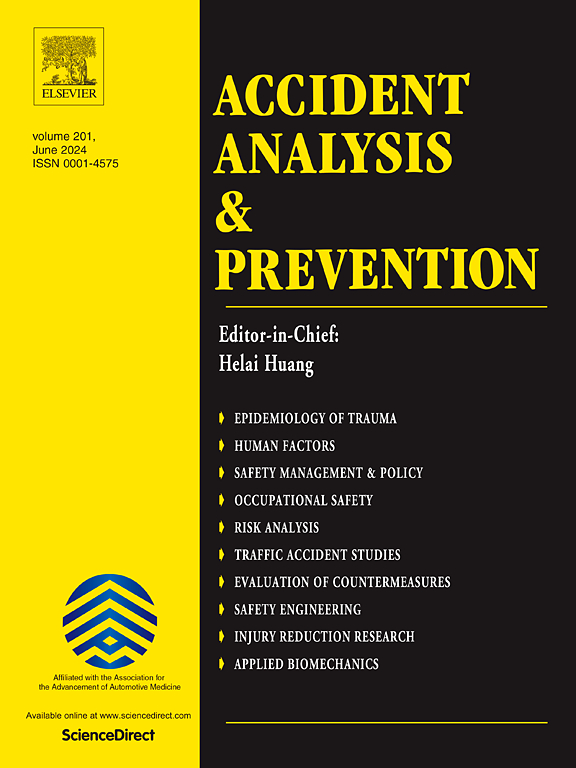自动驾驶汽车中减少行人伤害的智能安全系统的激活策略和有效性。
IF 5.7
1区 工程技术
Q1 ERGONOMICS
引用次数: 0
摘要
自动驾驶汽车的智能安全系统(ISS)集成了先进的感知能力和被动保护装置,有望重塑传统的行人安全系统,并在降低交通事故中行人受伤的风险方面发挥关键作用。然而,传统的主动控制和被动保护模块仍然脱节,因为没有足够的证据支持集成系统中协作策略的有效性,特别是在激活标准和时间方面。本研究旨在通过开发一种综合的ISS来解决这一差距,该ISS结合了先进的感知系统、车辆动态控制模块和可控的被动安全装置。此外,该研究还评估了触发策略在各种安全系统(包括自动紧急制动(AEB)、自动紧急转向(AES)和ISS)中最大限度地降低伤害风险的功效。为了实现这一目标,我们通过检查23个详细的碰撞案例,重建了碰撞前行人与车辆相互作用的动力学。这些病例是从现实世界的事故数据库中挑选出来的,包括清晰的视频记录和详细的伤害报告。此外,通过构建车辆转向和制动回避模型,分析了避碰边界条件。我们的研究结果表明,在现实世界的事故中,驾驶员避免碰撞所需的平均碰撞时间(TTC)为-3.15±1.00秒。AEB系统需要-1.06±0.23 s, AES系统需要-0.44±0.14 s。在此基础上,我们开发了用于系统激活的伤害风险模型,预测不同ttc的碰撞风险和行人伤害风险。行人伤害风险预测模型可有效预测20 ~ 70岁行人与汽车引擎盖碰撞导致AIS3 +头部损伤的风险。严重AIS3 +头部损伤风险的阈值设定为10%,ISS的触发TTC为-0.60±0.20秒。当系统在TTC为-0.5 s时启动时,它可以将行人严重头部受伤的概率降低59%。国际空间站的设计在提高行人安全方面显示出巨大的潜力。本研究结果可为自动驾驶汽车基于高级感知系统输入信号的被动安全装置的激活策略提供指导。本文章由计算机程序翻译,如有差异,请以英文原文为准。
Activation strategies and effectiveness of Intelligent safety systems for reducing pedestrian injuries in autonomous vehicles
Intelligent safety systems (ISS) for autonomous vehicles, integrating advanced perception capabilities and passive protection devices, are expected to reshape traditional pedestrian safety systems and play a key role in reducing the risk of pedestrian injuries in traffic accidents. However, traditional active control and passive protection modules remain disconnected due to insufficient evidence supporting the effectiveness of collaborative strategies in integrated systems, particularly concerning activation criteria and timing. This study aims to address this gap by developing a comprehensive ISS that incorporates advanced perception systems, a vehicle dynamic control module, and controllable passive safety devices. Furthermore, the study evaluates the efficacy of trigger strategies in minimizing injury risks in various safety systems including Automatic Emergency Braking (AEB), Automatic Emergency Steering (AES), and ISS. To achieve this, we reconstructed the dynamics of pedestrian-vehicle interactions before collisions by examining 23 detailed collision cases. These cases were selected from real-world accident databases and included clear video recordings and detailed injury reports. Additionally, we analyzed the boundary conditions for collision avoidance by constructing vehicle steering and braking avoidance models. Our findings indicate that, in real-world accidents, the average Time-to-Collision (TTC) required for drivers to avoid collisions is −3.15 ± 1.00 s. In contrast, the AEB system requires −1.06 ± 0.23 s, and the AES system requires −0.44 ± 0.14 s. Building on this, we developed injury risk models for the system activation, predicting collision risks at various TTCs and pedestrian injury risks. The pedestrian injury risk prediction model effectively forecasts the risk of AIS3 + head injuries resulting from collisions between pedestrians aged 20 to 70 years and the vehicle hood. The threshold for a severe AIS3 + head injury risk is set at 10 %, with a trigger TTC of the ISS at −0.60 ± 0.20 s. When the system is activated at a TTC of −0.5 s, it can reduce the probability of severe head injury to pedestrians by 59 %. The design of the ISS shows significant potential for enhancing pedestrian safety. The findings of this research can offer guidance for the activation strategies of passive safety devices based on input signals from advanced perception systems in AVs.
求助全文
通过发布文献求助,成功后即可免费获取论文全文。
去求助
来源期刊

Accident; analysis and prevention
Multiple-
CiteScore
11.90
自引率
16.90%
发文量
264
审稿时长
48 days
期刊介绍:
Accident Analysis & Prevention provides wide coverage of the general areas relating to accidental injury and damage, including the pre-injury and immediate post-injury phases. Published papers deal with medical, legal, economic, educational, behavioral, theoretical or empirical aspects of transportation accidents, as well as with accidents at other sites. Selected topics within the scope of the Journal may include: studies of human, environmental and vehicular factors influencing the occurrence, type and severity of accidents and injury; the design, implementation and evaluation of countermeasures; biomechanics of impact and human tolerance limits to injury; modelling and statistical analysis of accident data; policy, planning and decision-making in safety.
 求助内容:
求助内容: 应助结果提醒方式:
应助结果提醒方式:


